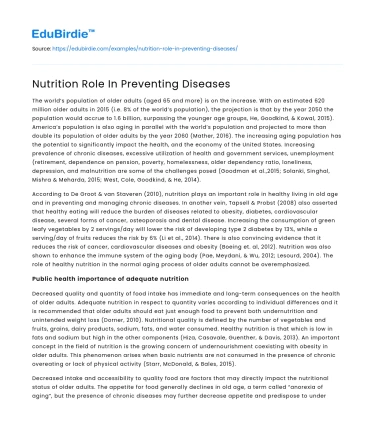The world’s population of older adults (aged 65 and more) is on the increase. With an estimated 620 million older adults in 2015 (i.e. 8% of the world’s population), the projection is that by the year 2050 the population would accrue to 1.6 billion, surpassing the younger age groups, He, Goodkind, & Kowal, 2015). America’s population is also aging in parallel with the world’s population and projected to more than double its population of older adults by the year 2060 (Mather, 2016). The increasing aging population has the potential to significantly impact the health, and the economy of the United States. Increasing prevalence of chronic diseases, excessive utilization of health and government services, unemployment (retirement, dependence on pension, poverty, homelessness, older dependency ratio, loneliness, depression, and malnutrition are some of the challenges posed (Goodman et al.,2015; Solanki, Singhal, Mishra & Meharda, 2015; West, Cole, Goodkind, & He, 2014).
According to De Groot & van Staveren (2010), nutrition plays an important role in healthy living in old age and in preventing and managing chronic diseases. In another vein, Tapsell & Probst (2008) also asserted that healthy eating will reduce the burden of diseases related to obesity, diabetes, cardiovascular disease, several forms of cancer, osteoporosis and dental disease. Increasing the consumption of green leafy vegetables by 2 servings/day will lower the risk of developing type 2 diabetes by 13%, while a serving/day of fruits reduces the risk by 6% (Li et al., 2014). There is also convincing evidence that it reduces the risk of cancer, cardiovascular diseases and obesity (Boeing et. al, 2012). Nutrition was also shown to enhance the immune system of the aging body (Pae, Meydani, & Wu, 2012; Lesourd, 2004). The role of healthy nutrition in the normal aging process of older adults cannot be overemphasized.
Save your time!
We can take care of your essay
- Proper editing and formatting
- Free revision, title page, and bibliography
- Flexible prices and money-back guarantee
Public health importance of adequate nutrition
Decreased quality and quantity of food intake has immediate and long-term consequences on the health of older adults. Adequate nutrition in respect to quantity varies according to individual differences and it is recommended that older adults should eat just enough food to prevent both undernutrition and unintended weight loss (Dorner, 2010). Nutritional quality is defined by the number of vegetables and fruits, grains, dairy products, sodium, fats, and water consumed. Healthy nutrition is that which is low in fats and sodium but high in the other components (Hiza, Casavale, Guenther, & Davis, 2013). An important concept in the field of nutrition is the growing concern of undernourishment coexisting with obesity in older adults. This phenomenon arises when basic nutrients are not consumed in the presence of chronic overeating or lack of physical activity (Starr, McDonald, & Bales, 2015).
Decreased intake and accessibility to quality food are factors that may directly impact the nutritional status of older adults. The appetite for food generally declines in old age, a term called “anorexia of aging”, but the presence of chronic diseases may further decrease appetite and predispose to undernutrition (Dorner, 2010; James, 2004). Other conditions that can negatively affect food intake include dementia, Parkinson’s disease, polypharmacy, stroke, etc. Frailty, poverty, social isolation, lack of transportation, poor food distribution/network may predispose to inability to access or obtain healthy food (Locher et al., 2005; Kowlessar, Robinson, & Schur, 2015; Vesnaver & Keller, 2011).
Despite well-documented benefits of healthy eating in old age, there exist disparity in accessing and obtaining healthy nutrition among community-dwelling older adults in the United states. It is well documented that malnutrition is predominant among older adults and may be as high as 30% among community-dwellers (Soenen & Chapman, 2013; Kaiser et al, 2010; Agarwal, Miller, Yaxley, & Isering, 2013). Being very old (75 years and above) has been proven to be an independent risk factor for the development of malnutrition (Silver, 2009). One study reported a prevalence of 15% among community-dwelling older adults and a much higher prevalence (23 – 62%) among institutionalized geriatric patients (Soenen & Chapman, 2013). The risk of having nutritional deficiencies is much higher among women, ethnic minorities, and rural-dwelling older adults (Silver, 2009). It is noteworthy that a higher rate of risk of malnutrition has been reported among older adults than those who did have it, the rate which could be as high as 76 – 83% (Hamirudin, Charlton, & Walton, 2016; Guigoz, 2006).
Therefore, identifying elderly individuals with risk of malnutrition is important in preventing the health care cost associated with the complications of malnutrition before they develop it. In addition, the risk of malnutrition is also associated with the likelihood of morbidity and mortality (Cederholm, 2017).






 Stuck on your essay?
Stuck on your essay?

